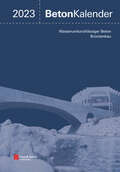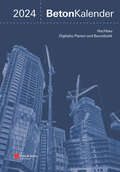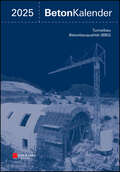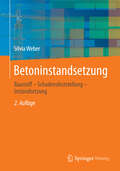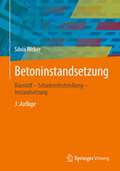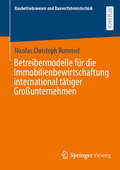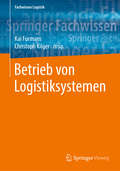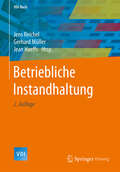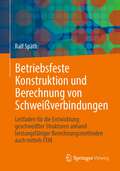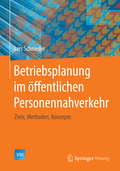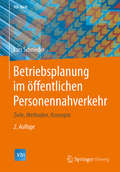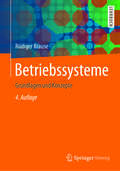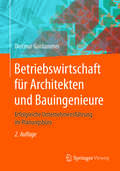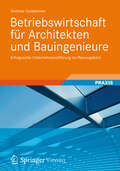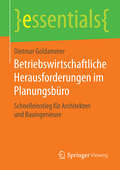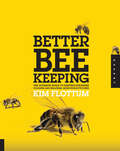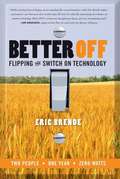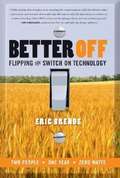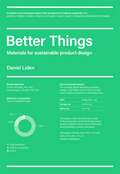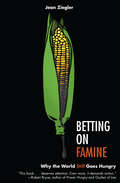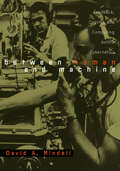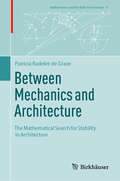- Table View
- List View
Beton-Kalender 2023: Schwerpunkte: Wasserundurchlässiger Beton, Brückenbau (2 Teile) (Beton-Kalender)
by Konrad Bergmeister WienDer Beton-Kalender 2023 widmet sich ausführlich dem aktuellen Regelwerk für die Planung und Herstellung wasserundurchlässiger Betonbauwerke. Den Einstieg in das Thema bilden ein Kommentar mit Erläuterungen zur DAfStb-Richtlinie über wasserundurchlässige Betonbauwerke sowie zwei Erläuterungsbeiträge zu den ÖBV- Richtlinien zur Planung und Herstellung von Weißen Wannen und bentonitgeschützten Bauwerken (Braunen Wannen). Weitere Beiträge widmen sich dem Betonbau beim Umgang mit wassergefährdenden Stoffen sowie der Abdichtung von Fugen und Durchdringungen bei wasserundurchlässigen Bauwerken. Die Beiträge zu Betonstahl und Spannstahl sowie zu Verankerungen und Bewehrungstechnik wurden von den jeweiligen Autorenteams auf den neuesten Stand gebracht. Abgerundet wird der erste Schwerpunkt im Band 1 durch einen Beitrag über Regelungen zur Abdichtung erdberührter Bauteile sowie dem vollständigen Abdruck der WU-Richtlinie des DAfStb vom Dezember 2017. Den weiteren Schwerpunkt im Band 2 bilden der Entwurf, Bemessung und Konstruktion von Betonbrücken nach den Regeln des Eurocode 2 in Deutschland. Neben einem Grundlagenbeitrag werden die besonderen Herausforderungen beim Großbrückenbau und beim Entwurf von Fußgänger- und Radwegbrücken in eigenständigen Kapiteln vertieft. Weitere Beiträge widmen sich dem Schallemissionsmonitoring zur Spanndrahtbruchdetektion bei Bestandsbauwerken sowie dem Erdbeben- und Schwingungsschutz beim Brückenneubau. Abgerundet wird der Band 2 mit einer aktuellen Einschätzung zu klimaverträglichen bzw. ökologisierten Betonen auf der Basis eines neuen Grenzzustandes der Klimaverträglichkeit und dem Kapitel "Normen und Regelwerke".
Beton-Kalender 2024: Schwerpunkte: Digitales Planen und Baurobotik; Hochbau (2 Teile) (Beton-Kalender Series)
by Konrad Bergmeister Frank Fingerloos Johann-Dietrich WornerDer Beton-Kalender 2024 widmet sich in Band 1 dem Entwurf, Bemessung und Konstruktion von Hochbauten aus Stahlbeton nach den aktuellen Regelwerken. Den Auftakt von Band 1 bildet der Beitrag Beton, welcher von den Autoren auf den aktuellen Stand gebracht wurde. Anschließend werden die besonderen Herausforderungen bei der Verwendung von Recyclingbetonen und Anpassungen der Bauweisen mit Blick auf die Kreislaufwirtschaft vertieft. Der Bau von Hochhäusern aus Stahlbeton entsprechend des aktuellen Regelwerkes und dem Stand des Wissens wird in einem Grundlagenbeitrag zu Entwurf und Konstruktion umfassend dargestellt. Die besonderen Herausforderungen bei der Gründung von Hochhäusern werden in einem separaten Beitrag vertieft. Abgerundet wird der Themenschwerpunkt mit Beiträgen zu nachträglich eingemörtelten Bewehrungsstäben, den Besonderheiten von tragenden wärme- und schallgedämmten Bauteilanschlüssen und Querkraftdornen und einer Stellungnahme des Bundesbauministeriums zu verschiedenen Fragen der Herausgeber über die Zukunft und Nachhaltigkeit im Hochbau. Den Schwerpunkt im Band 2 bilden das Digitale Planen und die Baurobotik. Einzelbeiträge zur integralen 3D Architektur- und Tragwerksplanung mit BIM, der Digitalisierung der Versuchsdurchführung und des Monitorings von Bauwerken und die Anwendung von KI-Methoden zur Integration tragwerksplanerischen Wissens in frühe Phasen des Gebäudeentwurfs zeigen, wie vielschichtig und tiefgreifend der digitale Wandel die Planungsprozesse durchdringt. Ergänzt wird der Schwerpunkt mit einem Blick auf den Datenraum für Nachhaltigkeit im Bauwesen und den Anforderungen an die Prüffähigkeit digitaler 3D-Planungen. Über Fortschritte bei der Digitalisierung der Bauausführung informiert anschließend der Beitrag Bauautomatisierung und Robotik im Betonbau mit diversen Fallstudien zu Forschung, Entwicklung und Innovation. Abgerundet wird der Band 2 mit dem Kapitel "Normen und Regelwerke", einschließlich der abgedruckten DAfStb-Richtlinie für Beton nach DIN EN 206-1 und DIN 1045-2 mit rezyklierten Gesteinskörnungen nach DIN EN 12620 mit Berichtigung 1.
Beton-Kalender 2025: Schwerpunkte (2 Teile) (Beton-Kalender)
by Frank Fingerloos Berlin Konrad Bergmeister Wien Frank Johann-Dietrich Wörner DarmstadtDie Beiträge zum Themenschwerpunkt "Tunnelbau" in Band 1 umfassen eine breite Palette von Themen, die von technischen Verfahren bis hin zu digitalen Technologien und Nachhaltigkeitsaspekten reichen. Im Bereich der Bauverfahren wird sowohl der konventionelle Tunnelbau bei geringer Überdeckung als auch der maschinelle Tunnelvortrieb mit seinen Verfahrenstechniken, Planungsgrundlagen und spezifischen Herausforderungen thematisiert. Anschließend werden Tübbing-Fertigteile, Injektionen im Tunnelbau sowie die Besonderheiten unterirdischer gleisgebundener Verknüpfungsstellen in drei Einzelbeiträgen behandelt. Die Digitalisierung spielt eine zunehmend wichtige Rolle im Tunnelbau, was durch Beiträge zu BIM (Building Information Modeling)-basierter Nachhaltigkeitsbewertung, zum Tunnel Information Modeling als Schritt hin zum digitalen Zwilling, der allgemeinen Digitalisierung in Planung, Ausführung und Betrieb sowie Sensorik und Langzeitmonitoring deutlich wird. Abschließend wird das Risikomanagement bei Großprojekten im Tunnelbau angesprochen, was die Komplexität und die Herausforderungen unterstreicht, die mit solchen Vorhaben verbunden sind, einschließlich der Notwendigkeit, Risiken zu identifizieren, zu bewerten und zu steuern. Den Auftakt von Band 2 bildet ein Beitrag zu Windenergieanlagen in Stahlbeton- und Spannbetonbauweise, gefolgt von neuen bzw. aktualisierten Beiträgen, die auf die im Jahr 2023 neu herausgegebene Normenreihe der DIN 1045 eingehen. In der neuen DIN 1045-1000 wird ein Konzept der Betonbauqualitätsklassen (BBQ-Klassen) für komplexere Planungs- und Bauaufgaben im Betonbau etabliert, welches in den überarbeiteten Normen DIN 1045-1 (Planung, Bemessung, Konstruktion, DIN 1045-2 (Beton) und DIN 1045-3 (Bauausführung) detailliert und spezifiziert umgesetzt wird. Abgerundet wird der Band 2 mit dem Kapitel "Normen und Regelwerke", einschließlich der neuen DAfStb-Richtlinie "Betondecken und -dächer aus Fertigteilhohlplatten" vom Januar 2023.
Betoninstandsetzung: Baustoff - Schadensfeststellung - Instandsetzung
by Silvia WeberIn den letzten Jahren ist ein eigenes Arbeitsgebiet der Instandsetzungs- und Erhaltungsma#65533;nahmen von Bauwerken aus Stahlbeton - mit neuen Verfahren und Produkten - entstanden. Die detaillierte Darstellung der Autorin gibt dem Leser ein umfassendes Verst#65533;ndnis f#65533;r das Thema Betoninstandsetzung. Normen und Richtlinen, Schadensf#65533;lle, Methoden der Instandsetzung oder auch die Vergabe von Auftr#65533;gen sind umfassend erkl#65533;rt. Vertragliche und technische Besonderheiten sind dabei extra herausgestellt und durch Hinweise auf die jeweils geltenden Regelwerke erg#65533;nzt. Das Buch enth#65533;lt au#65533;erdem wichtige Checklisten f#65533;r Untersuchungen und Beispielgutachten. Ein Muss f#65533;r jeden, der dauerhaft Beton instandsetzen m#65533;chte!
Betoninstandsetzung: Baustoff – Schadensfeststellung – Instandsetzung
by Silvia WeberBetonbauwerke und Bauteile aus Beton stellen einen bedeutenden Teil des Staats- und Privatvermögens dar. Wie an allen anderen Bauwerke werden auch an Bauwerke aus diesem sehr leistungsfähigen und robusten Baustoff werterhaltenden Maßnahmen wie Erhalten und Instandsetzung durchgeführt. Die interdisziplinären Tätigkeiten, die hohe Anforderungen an das Fachwissen und die Materialkenntnisse des Planenden und des Ausführenden stellen und die kontinuierlich an Komplexität zunehmen, gewinnen an Bedeutung und steigen rasant an. Neue technologische Errungenschaften und vor allem die Neuerungen in den Regelwerken machen es daher erforderlich, sich über die aktuellen Entwicklungen besonders in Bezug auf die Prinzipien und Methoden der Instandsetzung sowie der Verwendbarkeit von Baustoffen umfassend zu informieren. Viele Fachplaner und Baubetriebe befürchten infolge der anstehenden Einführung der “Technischen Regel Instandhaltung von Betonbauwerke” des Deutschen Instituts für Bautechnik eine Rechtsunsicherheit in der Planung und Ausführung und somit Probleme bei der Anwendung dieses Regelwerkes in der Praxis.Das Ziel dieser Auflage: Eine einfache und vor allem praktikable Handhabung der aktuellen europäischen und nationalen Regelwerke für das Planen und die Ausführung der Instandsetzungsarbeiten von Bauwerke oder Bauteile aus Beton.
Betrayed (The Black Hat Thrillers #3)
by Karen E. OlsonA computer hacker working to clear her name discovers a dangerous threat could closer than she knows in this technothriller from the author of Hidden. Framed for ordering a hit on mobster Tony DeMarco, Tina Adler is forced to re-enter the shadowy world of computer hacking she thought she&’d left behind. In order to clear her name, she reluctantly joins an FBI team led by her old flame, Zeke Chapman, tasked with scouring the deep web to unearth DeMarco&’s darkest secrets. The trail will lead Tina to the person who framed her—but it may also reveal other secrets, secrets she would rather not know. DeMarco may, in fact, be the least of Tina&’s worries. Her true enemy just might be someone much closer to home…&“Adrenaline-charged…Although technology is at the heart of the story, don&’t expect any geeky dependence on techie minutiae in this well-written, character-driven thriller.&”—Publishers Weekly&“[A] high-tension series…The finale will leave everyone wanting more.&”—Kirkus Reviews
Betrayed: An Altered Saga Novella (Altered)
by Jennifer RushAfter leaving Anna, Sam, Cas, and Nick behind, Trev is on his own and under the watchful eye of the Branch once more. But where do Trev's loyalties really lie? Riley, Trev's overseer, is determined to find out. On Riley's command, Trev sets off on a mission to a small Wisconsin suburb. His order: locate and kill a seemingly innocent teen named Charlie. Trev soon learns, though, not everything is as it seems in this quiet town--most of all Charlie.Find out what Trev's been up to behind the scenes in this Altered Saga original short story.word count: 10,910 words
Betreibermodelle für die Immobilienbewirtschaftung international tätiger Großunternehmen (Baubetriebswesen und Bauverfahrenstechnik)
by Nicolas Christoph RummelIn diesem Buch werden auf der Grundlage empirischer Erhebungen die Gestaltungsmöglichkeiten des betrieblichen Immobilienmanagements und die Erfolgspotenziale einer an der Unternehmensstrategie ausgerichteten Immobilienstrategie untersucht. Es werden verschiedene Betreibermodelle für die Bewirtschaftung des Immobilienbestandes entwickelt, anhand einer Nutzwertanalyse bewertet und ihre Erfolgswirkungen aufgezeigt. Aus der Analyse ergibt sich ein nutzenmaximales Betreibermodell, das aus wissenschaftlicher Sicht zur Umsetzung empfohlen werden kann. Neben der Erweiterung des wissenschaftlichen Kenntnisstandes liefert die Arbeit zahlreiche Ansätze für die praktische Anwendung sowohl im betrieblichen Immobilienmanagement als auch bei Dienstleistungsunternehmen im Facility Management.
Betrieb von Logistiksystemen (Fachwissen Logistik)
by Christoph Kilger Kai FurmansLogistik fordert hohes technologisches Grundwissen und den engen Bezug zur Praxis, aber auch die Kenntnis geeigneter theoretischer Grundlagen. Aus dem Werk "Handbuch Logistik" gewinnen einzelne Beiträge an Bedeutung, die aktualisiert aufbereitet und neu zusammengestellt werden.
Betriebliche Instandhaltung (VDI-Buch)
by Gerhard Müller Jens Reichel Jean HaeffsIn seiner über 30-jährigen Geschichte hat sich der VDI-Hauptausschuss darum bemüht, dass das Thema Instandhaltung öffentlich diskutiert und wissenschaftlich untersucht wird. Erkenntnisse zu effizienten Vorgehensweisen, Methoden und Strategien sind zum Teil in Richtlinien dokumentiert. Das Buch reflektiert die Entwicklung der Instandhaltung in den letzten Jahren. Es sammelt die Beiträge zur Festveranstaltung im Juni 2009.
Betriebsfeste Konstruktion und Berechnung von Schweißverbindungen: Leitfaden für die Entwicklung geschweißter Strukturen anhand leistungsfähiger Berechnungsmethoden auch mittels FEM
by Ralf SpäthSchweißverbindungen zählen nach wie vor zu den wichtigsten stoffschlüssigen Verbindungen. Für die Betriebsfestigkeitsberechnung dieser Verbindungen gibt es zahlreiche Normen und Vorgaben – das Einordnen der verschiedenen Methoden ist auch für den versierten Ingenieur nicht immer einfach. Darüber hinaus wird die FEM-Methode immer wichtiger – auch hier gibt es eine Vielzahl von Modellierungsansätzen. In diesem Buch werden die Grundlagen und die Zusammenhänge der Betriebsfestigkeit von Schweißverbindungen anschaulich und praxisgerecht erläutert, sowohl auf der Basis von „Handrechnungen“ als auch mit FEM-Methoden. Der Leser ist damit in der Lage auch kritische Schweißverbindungen sicher schwingfest zu gestalten, zu berechnen sowie begleitende Labortests zielgerichtet zu planen.
Betriebsplanung im öffentlichen Personennahverkehr: Ziele, Methoden, Konzepte (VDI-Buch)
by Lars SchniederMit diesem Buch erhält der Leser einen umfassenden Einblick in alle für die Planung, Durchführung und Kontrolle des Betriebs öffentlicher Personenverkehrssysteme (ÖPNV) relevanten Aufgaben. Eine besondere Beachtung finden hierbei verkehrsträgerspezifische Besonderheiten, da der Betrieb öffentlicher Personenverkehrssysteme unterschiedlichen Randbedingungen und einer großen Bandbreite einwirkender Störgrößen unterliegt. Die vergleichende Darstellung der Merkmale der Verkehrsträger sowie deren Auswirkung auf die Betriebsplanung fördert das Verständnis der planerischen Aufgaben. Das Buch "Betriebsplanung im öffentlichen Personennahverkehr" ist eine ganzheitliche und übersichtlich strukturierte Darstellung der einzelnen Planungsschritte in Verkehrsunternehmen in ihrem Zusammenhang. Vorhandene Methoden und Lösungsmöglichkeiten werden zusammengestellt und vergleichend diskutiert. Das Buch schließt die bestehende Lücke in der Fachliteratur. Es richtet sich an Angebotsplaner in Verkehrsverbünden, Betriebsplaner in Verkehrsunternehmen sowie planerisch tätigen Mitarbeitern in Ingenieurbüros. Studierende der Verkehrswissenschaften finden im vorliegenden Buch die für die beruflichen Aufgaben notwendige fachliche Vertiefung.
Betriebsplanung im öffentlichen Personennahverkehr: Ziele, Methoden, Konzepte (VDI-Buch)
by Lars SchniederMit diesem Buch erhält der Leser einen umfassenden Einblick in alle für die Planung, Durchführung und Kontrolle des Betriebs öffentlicher Personennahverkehrssysteme (ÖPNV) relevanten Aufgaben. Eine besondere Beachtung finden hierbei verkehrsträgerspezifische Besonderheiten, da der Betrieb des ÖPNV unterschiedlichen Randbedingungen und einer großen Bandbreite einwirkender Störgrößen unterliegt. Die vergleichende Darstellung der Merkmale der Verkehrsträger sowie deren Auswirkung auf die Betriebsplanung fördert das Verständnis der planerischen Aufgaben. Dieses Buch ist eine ganzheitliche und übersichtlich strukturierte Darstellung der einzelnen Planungsschritte in Verkehrsunternehmen in ihrem Zusammenhang. Vorhandene Methoden und Lösungsmöglichkeiten werden zusammengestellt und vergleichend diskutiert.Das Buch bietet beruflichen Neueinsteigern in die Verkehrsbranche eine gute fachliche Einführung in die Komplexität des Systems ÖPNV. Studierende und Lehrende an Hochschulen profitieren von einer strukturierten und ganzheitlichen Darstellung planerischer Prozesse. Für Ingenieurbüros und weitere am Planungsprozess Beteiligte (Politiker, Besteller, Ersteller) liegt der besondere Wert dieses Buches unter anderem in den umfangreichen kapitelbezogenen Literaturverzeichnissen begründet. Diese umfassen alle wesentlichen zum Fachgebiet gehörenden Schriften des zuständigen Verbandes und bieten auf diese Weise einen Ansatzpunkt für eine weiterführende Recherche.
Betriebssysteme: Grundlagen und Konzepte
by Rüdiger BrauseDer Autor präsentiert die Grundlagen und Konzepte der heutigen Betriebssysteme und behandelt die Gebiete Prozesse (Prozesszustände, Prozessscheduling, Prozesssynchronisation und Prozesskommunikation), Speicherverwaltung (virtueller Speicher, paging, swapping), Dateiverwaltung (Files, Ordner, Sicherheitsmechanismen), Ein-und Ausgabeverwaltung (Treiber, I/O-memory mapping, Systemfunktionen) sowie Netzwerke (Netzwerkschichten, Arbeitsverteilung, Schattenserver) und Sicherheitsmechanismen (Angriffsarten, root kits, Kerberos). Dabei werden sowohl Einprozessor- als auch Mehrprozessorsysteme betrachtet und die Konzepte an wichtigen existierenden Betriebssystemen wie Unix und Windows NT verdeutlicht.In der vorliegenden vierten Auflage wurden viele Erfahrungen aus der Lehrpraxis berücksichtigt. So wurden nicht nur die Entwicklungen in Windows NT und Unix, speziell Linux, aktualisiert, sondern auch einige Kapitel neu gegliedert und um das Thema „Sicherheit“ ergänzt. Weitere Aufgaben und Beispiele mit Musterlösungen runden das Werk ab. Alle Vorlesungsfolien, die Vorlesungsvideos sowie eine umfangreiche Klausursammlung mit Musterlösungen stehen auf den Webseiten des Autors zum Herunterladen bereit.
Betriebswirtschaft für Architekten und Bauingenieure
by Dietmar GoldammerDieses Fachbuch vermittelt das Basiswissen der Betriebswirtschaft und befähigt den Planer, die angemessenen Rahmenbedingungen für sein Unternehmen zu schaffen, erfolgreich zu kommunizieren, Mitarbeiter zu führen, Chancen und Risiken zu erkennen, die Profitabilität zu messen und zu lenken und so den langfristigen wirtschaftlichen Erfolg seines Büros sicherzustellen.
Betriebswirtschaft für Architekten und Bauingenieure: Erfolgreiche Unternehmensführung im Planungsbüro
by Dietmar GoldammerFür die erfolgreiche Führung eines Planungsbüros reicht es nicht aus, technisch perfekt zu sein. Architekten und Ingenieure in leitenden Positionen müssen auch die Verantwortung für den wirtschaftlichen Erfolg von Projekten übernehmen. Dazu ist es unerlässlich, dass sie die betriebswirtschafltichen Zusammenhänge kennen und Methoden und Werkzeuge zur Steuerung anwenden können. Diese Fachbuch vermittelt das Basiswissen der Betriebswirtschaft und befähigt den Planer, die angemessenen Rahmenbedingungen für sein Unternehmen zu schaffen, die Profitabilität zu messen und zu lenken und so den langfristigen finanziellen Erfolg seines Büros sicherzustellen.
Betriebswirtschaftliche Herausforderungen im Planungsbüro: Schnelleinstieg für Architekten und Bauingenieure (essentials)
by Dietmar GoldammerDietmarGoldammer zeigt wie sich Architektur- und Ingenieurbüros auf veränderteArbeitswelten, soziale Verantwortung und Nachhaltigkeit als neueHerausforderungen einstellen müssen. Der Autor beschreibt Frühwarnsysteme,Zertifizierungen und neue Organisationsformen, die dabei helfen. Erthematisiert auch, wie die Regelung der Nachfolge des Unternehmers ausgestaltetwerden kann. So zeigt sich: Der gesellschaftliche Wandel ist auch in denPlanungsbüros angekommen. Es wäre ein Leichtsinn zu glauben, dass dort alles soweiter geht wie bisher. Das Essential hilft kurz und prägnant, die richtigenSchritte anzustoßen.
Better Beekeeping: The Ultimate Guide to Keeping Stronger Colonies and Healthier, More Productive Bees
by Kim Flottum“The most lucid call to action ever written about land-based beekeeping” from the author of The Backyard Beekeeper (Tammy Horn, author of Bees in America and Beeconomy).Backyard beekeepers everywhere agree: a successful colony is a thing of beauty.Thousands of beekeepers have started beekeeping thanks to Kim Flottum’s first book, The Backyard Beekeeper, and they have added to their repertoire of skills with The Backyard Beekeeper’s Honey Handbook. Now, Better Beekeeping answers the question, “What do I do now that I’m a beekeeper?” This book takes serious beekeepers past the beginning stages and learning curves and offers solutions and rewards for keeping bees a better way. Better queens, better winters, better food, and better bees await any beekeeper willing to take on the challenge of having the right number of bees, of the right age, in the right place, in the right condition, at the right time.“There are numerous beekeeping books on the shelves that instruct on ‘how to,’ but Better Beekeeping is a book that explores ‘why to,’ which is essential for this ever-changing world of beekeeping today.” —Jennifer Berry, research coordinator at the University of Georgia’s Honey Bee Research Lab, commercial queen, and columnist for Bee Culture magazine
Better Off
by Eric BrendeWhat happens when a graduate of MIT, the bastion of technological advancement, and his bride move to a community so primitive in its technology that even Amish groups consider it antiquated? Eric Brende conceives a real-life experiment: to see if, in fact, all our cell phones, wide-screen TVs, and SUVs have made life easier and better -- or whether life would be preferable without them. By turns, the query narrows down to a single question: What is the least we need to achieve the most? With this in mind, the Brendes ditch their car, electric stove, refrigerator, running water, and everything else motorized or "hooked to the grid" and begin an eighteen-month trial run -- one that dramatically changes the way they live, and proves entertaining and surprising to readers. Better OFF is a smart, often comedic, and always riveting book that also mingles scientific analysis with the human story, demonstrating how a world free of technological excess can shrink stress -- and waistlines -- and expand happiness, health, and leisure. Our notion that technophobes are backward gets turned on its head as the Brendes realize that the crucial technological decisions of their adopted Minimite community are made more soberly and deliberately than in the surrounding culture, and the result is greater -- not lesser -- mastery over the conditions of human existence.
Better Off: Flipping the Switch on Technology
by Eric BrendeIn this social experiment, author Brende and his wife live in a primitive and remote community and rid their lives of anything motorized or electric. Describes how the author feels that such a life can decrease stress and increase one's happiness and health.
Better Things: Materials for Sustainable Product Design
by Daniel LidenHow often have you seen a label on a product proclaiming it to be made from 'recycled material', 'bioplastic' or similar, without it giving any details of the concrete environmental benefits? What do these terms really mean? A drive for greater transparency and demonstrable environmental benefits is happening in product design, through emerging legislation and standards, and consumer demand for more sustainable products and unambiguous marketing. In Better Things: Materials for Sustainable Product Design, Daniel Liden seeks to tackle the lazy 'greenwashing' terminology we see every day, providing a guide for product designers, manufacturers and consumers wishing to make better and more informed decisions about materials. The book comprises six chapters devoted to material categories - plastics, textiles, metals, ceramics and glass, wood and paper - and a seventh chapter covering emerging sustainable technologies. Each chapter includes interviews with industry experts, as well as photos, diagrams, environmental impact data, general material properties and more.
Better Things: Materials for Sustainable Product Design
by Daniel LidenHow often have you seen a label on a product proclaiming it to be made from 'recycled material', 'bioplastic' or similar, without it giving any details of the concrete environmental benefits? What do these terms really mean? A drive for greater transparency and demonstrable environmental benefits is happening in product design, through emerging legislation and standards, and consumer demand for more sustainable products and unambiguous marketing. In Better Things: Materials for Sustainable Product Design, Daniel Liden seeks to tackle the lazy 'greenwashing' terminology we see every day, providing a guide for product designers, manufacturers and consumers wishing to make better and more informed decisions about materials. The book comprises six chapters devoted to material categories - plastics, textiles, metals, ceramics and glass, wood and paper - and a seventh chapter covering emerging sustainable technologies. Each chapter includes interviews with industry experts, as well as photos, diagrams, environmental impact data, general material properties and more.
Betting on Famine: Why the World Still Goes Hungry
by Jean Ziegler&“The seminal book on global poverty and hunger . . . How rapacious speculators and complicit bureaucrats are starving a billion people&” (Wenonah Hauter, executive director of Food & Water Watch and author of Foodopoly). Few people know that world hunger was very nearly eradicated in our lifetimes. In the past five years, however, widespread starvation has suddenly reappeared, and chronic hunger is a major issue on every continent. In an extensive investigation of this disturbing shift, Jean Ziegler—one of the world&’s leading food experts—lays out in clear and accessible terms the complex global causes of the new hunger crisis. Ziegler&’s wide-ranging and fascinating examination focuses on how the new sustainable revolution in energy production has diverted millions of acres of corn, soy, wheat, and other grain crops from food to fuel. The results, he shows, have been sudden and startling, with declining food reserves sending prices to record highs and a new global commodities market in ethanol and other biofuels gobbling up arable lands in nearly every continent on earth. Like Raj Patel&’s pioneering Stuffed and Starved, Betting on Famine will enlighten the millions of Americans concerned about the politics of food at home—and about the forces that prevent us from feeding the world&’s children. &“In this devastating book, [Ziegler] describes the horrors of food insecurity, the callousness of &‘crusaders of neoliberalism&’ who control food and land access, and the individuals and grassroots organizations fighting for subsistence farmers and the right to food.&” —Publishers Weekly (starred review) &“Passionate, well-researched, objective, and illuminating . . . When we close this book, indignant, we know that those who die of hunger are victims of money and power.&” —L&’Express
Between Human and Machine: Feedback, Control, and Computing before Cybernetics (Johns Hopkins Studies in the History of Technology)
by David A. MindellToday, we associate the relationship between feedback, control, and computing with Norbert Wiener's 1948 formulation of cybernetics. But the theoretical and practical foundations for cybernetics, control engineering, and digital computing were laid earlier, between the two world wars. In Between Human and Machine: Feedback, Control, and Computing before Cybernetics, David A. Mindell shows how the modern sciences of systems emerged from disparate engineering cultures and their convergence during World War II. Mindell examines four different arenas of control systems research in the United States between the world wars: naval fire control, the Sperry Gyroscope Company, the Bell Telephone Laboratories, and Vannevar Bush's laboratory at MIT. Each of these institutional sites had unique technical problems, organizational imperatives, and working environments, and each fostered a distinct engineering culture. Each also developed technologies to represent the world in a machine.At the beginning of World War II, President Roosevelt established the National Defense Research Committee, one division of which was devoted to control systems. Mindell shows how the NDRC brought together representatives from the four pre-war engineering cultures, and how its projects synthesized conceptions of control, communications, and computing. By the time Wiener articulated his vision, these ideas were already suffusing through engineering. They would profoundly influence the digital world. As a new way to conceptualize the history of computing, this book will be of great interest to historians of science, technology, and culture, as well as computer scientists and theorists. Between Human and Machine: Feedback, Control, and Computing before Cybernetics
Between Mechanics and Architecture: The Mathematical Search for Stability in Architecture (Mathematics and the Built Environment #8)
by Patricia Radelet-de GraveThis collection of essays reflects the author's decades-long dedication to studying the interplay between mechanics and architecture. It explores how advancements in mechanics have influenced architectural innovation and how the need for new architectural solutions has driven theoretical progress in engineering. By examining the historical roots of these fields, these essays provide a deep analysis of key developments. This interdisciplinary work will appeal to scholars, students, and anyone interested in the complex relationship between the theoretical and practical aspects of architecture and civil engineering.
